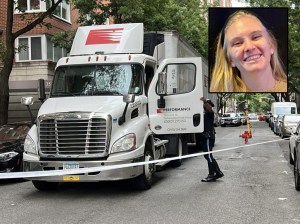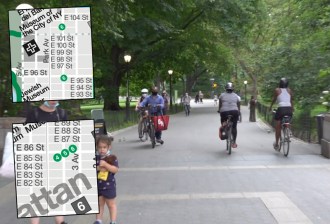CB8 Shoots Down Upper East Side Crosstown Bike Route Plan

On Monday, July 9 the transportation committee of Community Board 8 on Manhattan’s Upper East Side took up the issues of congestion pricing and a new pair of crosstown bike lanes.
Congestion pricing, it turns out, was the evening’s non-controversial issue. Even after a series of impassioned speeches against Mayor Bloomberg’s traffic reduction plan the committee voted to support it, 10 to 4 with one abstention.
"You’ve treated us to quite a debate," Dept. of Transportation Bike Program Coordinator Josh Benson said as he stood up to present the 90th and 91st Street bike route plan (download it here).
"You haven’t heard anything yet," heckled one member of the crowd.

Ryder Pearce sells DOT’s Upper East Side bike route plan to a skeptical Community Board 8.
Benson then introduced DOT staffer Ryder Pearce, a youthful member of the City’s Urban Fellows program, making his first-ever Community Board presentation.
As a part of the City’s ongoing bike network build-out, Pearce said, DOT plans to stripe new, Class II bike lanes along E. 90th and E. 91st Streets with a small segment running along E. 89th Street near the East River and a special treatment for the pedestrian-only block of 91st Street between Second and Third Avenues.
"As you can see there are no crosstown routes on the Upper East Side right now," Pearce said, pointing to the New York City bike map. The new lanes would connect the East River Greenway directly to Central Park’s 90th Street entrance, also known as the Engineer’s Gate. Along the way, the bike route would link Carl Schurz Park, Gracie Mansion, Asphalt Green and the Guggenheim Museum and "would provide for the growing residential population" living in new towers around York and East End Avenues, a long walk from the nearest subways.
Controversy over the bike route centered around the one-block stretch of 91st St. running through the Ruppert Yorkville Tower Condominiums. The block has been closed to motor vehicle traffic since the 1970s and is considered by many to be a neighborhood "play street."

Recognizing the community’s concerns, DOT presented the Board with four different design options for the pedestrian street: no markings, a marked bicycle lane, directional pavement markings and signs. DOT’s preference, Pearce said, is "to keep the residential feel" of the "shared space" by not putting down a bike lane or any other markings. For a number of people in the room, none of the options were good.
"There are children and elderly who consider that street a park," one Yorkville Tower resident said. "People want to walk there without having to look both ways and worry about getting run over. I am absolutely opposed to this bike path."
Pearce pointed out that cyclists on the westbound street would be traveling up a rather steep hill. He observed the street during several site visits, noting, "You don’t see cyclists shooting through. You don’t see them running people over." An older man in the crowd shouted back, "Oh, yes they do!"
Four or five community members stood to speak on behalf of the bike route plan. As seems to be the case in most New York City bike lane battles these days, supporters had youth on their side, opponents had New York City accents.
Glenn McAnanama, president of the Upper Green Side said he thought DOT had chosen the ideal crosstown bike route. "Ninety-first Street is the natural connection from the Greenway to the Park," he said. "If you go too much further north you’re getting into a lot of traffic at 96th and further south, you’re not connecting to the Central Park entrance."
"The fears are overblown," McAnanama said. He pointed to the new bike route running through Carl Schurz Park at East End Avenue and 86th Street as an example of "shared space" working in the neighborhood. "People were very afraid before the lanes were put in, but there haven’t been any problems," he said. "Cyclists know and sense a shared space.
Members of the Community Board weren’t convinced. One Board member said, "I for one believe bicycling is a recreational activity. I don’t believe that it is a legitimate mode of transportation."
As the meeting wound down and it became clear that DOT’s plan wasn’t going to gain CB8’s blessing on this night, a man in the crowd began dictating a motion to committee chair Chuck Warren:
Whereas illegal biking is found more often than legal biking; Whereas biking causes danger to children and old people; Whereas bicyclists should be licensed in the City of New York and an extensive education program should be inaugurated and the bicycle laws strictly enforced at all times so that they obey the traffic laws…
The committee’s final resolution didn’t include this language. It rejected DOT’s plan and asked the agency to go back to the drawing board. Community Boards, it is important to remember, only have "advisory" power over city agencies and City Hall has said that it would go forward with its bike network build-out over Community Board objections.

